
Dutch postcard by S. & v. H., A. Photo: M.P.E.A.
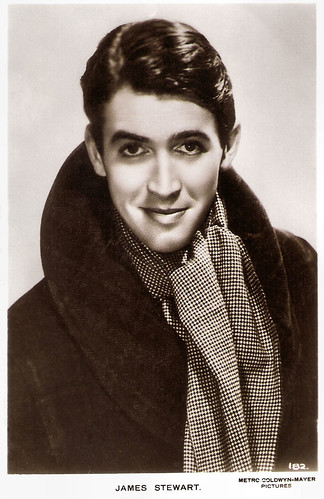
British "Real Photograph" postcard, no. 182. Photo: Metro Goldwyn Mayer.
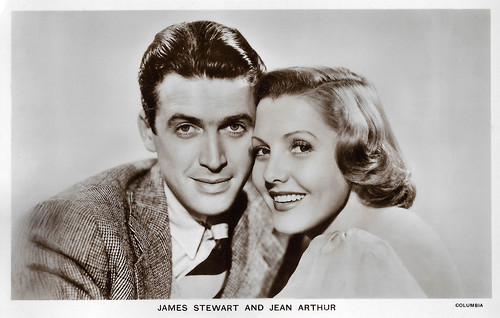
British postcard in the Film Partners Series, London, no. P 265. Photo: Columbia. James Stewart and Jean Arthur in You Can't Take It with You (Frank Capra, 1938).
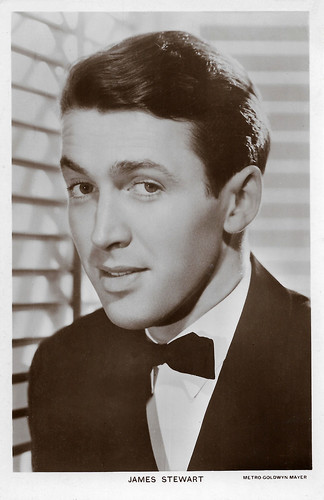
British postcard in the Picturegoer Series, London, no. 1214a (a former owner wrote: 1080A). Photo: Metro-Goldwyn-Mayer.
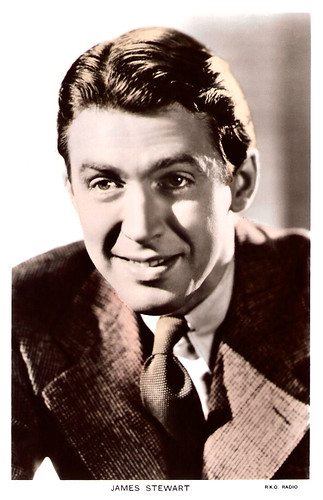
British Handcoloured Real Photograph postcard in the Colourgraph Series, London, no. C 303 Photo: R.K.O. Radio.

Dutch postcard. Photo: Universal International. James Stewart in Harvey (Henry Koster, 1950).
A screen persona as the likable "everyman"
James Maitland Stewart was born in 1908, in Indiana, Pennsylvania. His parents were Elizabeth Ruth (Johnson) and Alexander Maitland Stewart, who owned a hardware store. 'Jimmy' was educated at a local prep school, Mercersburg Academy, where he was a keen athlete (football and track), musician (singing and accordion playing), and sometime actor.
In 1929, he won a place at Princeton University. Stewart graduated from Princeton in 1932 with a degree in architecture. He then became part of the University Players, a summer stock company in Falmouth, Massachusetts. There he met Henry Fonda, and the two became lifelong friends. He appeared on Broadway and in summer stock productions. Work dried up as the Great Depression deepened, and it was not until 1934, when he followed Fonda to Hollywood, that things began to pick up.
In 1935, he signed a film contract with Metro-Goldwyn-Mayer (MGM). He made his film debut in The Murder Man (Tim Whelan, 1935) with Spencer Tracy. The studio did not see leading man material in Stewart, but after three years of supporting roles and being loaned out to other studios, he had his big breakthrough in Frank Capra's ensemble comedy You Can't Take It with You (1938) at Columbia.
Adapted from the Pulitzer Prize-winning play of the same name by George S. Kaufman and Moss Hart, You Can't Take It with You is about a man (Stewart) from a family of rich snobs who becomes engaged to a woman (Jean Arthur) from a good-natured but decidedly eccentric family. Stewart's unpretentious engaging manner, led to quick acceptance by the moviegoing public.
The following year, Stewart got his first Oscar nomination for his portrayal of a shy idealistic young senator fighting corruption in Congress in Capra's Mr. Smith Goes to Washington (Frank Capra, 1939), again opposite Jean Arthur. These roles established his screen persona as the likable "everyman". He won the Academy Award for his work in the screwball comedy The Philadelphia Story (George Cukor, 1940), which also starred Katharine Hepburn and Cary Grant.
A licensed amateur pilot, Stewart enlisted as a private in the Army Air Corps as soon as he could after the United States entered the Second World War in 1941. Although still an MGM star, his only public and film appearances in 1941—1945 were scheduled by the Air Corps. After fighting in the European theater of war, he had attained the rank of colonel and had received several awards for his service. He remained in the U.S. Air Force Reserve and was promoted to brigadier general in 1959. He retired in 1968 and was awarded the United States Air Force Distinguished Service Medal.
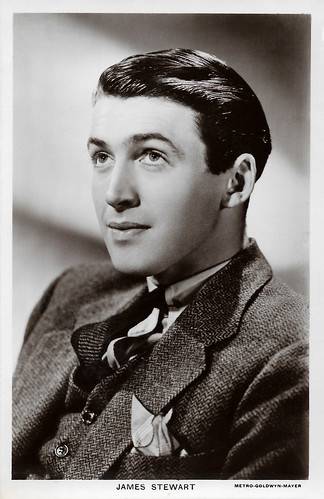
British postcard in the Picturegoer Series, London, no. 1080. Photo: Metro-Goldwyn-Mayer.

British postcard in the Picturegoer Series, London, no. 1214a. Photo: Metro-Goldwyn-Mayer.

British postcard in the Film Partners Seriesm London, no. P 199. Photo: Universal. James Stewart and Margaret Sullavan in Next Time We Love (1936).

Dutch postcard by Fotoarchief Film en Toneel, no. 3440. Photo: 20th Century Fox. James Stewart in Call Northside 777 (Henry Hathaway, 1948).
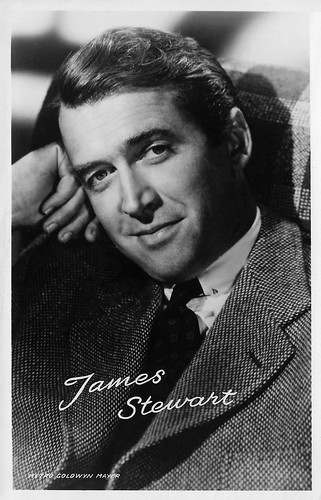
Dutch postcard. Photo: Metro Goldwyn Mayer.
A career revival by playing darker, more morally ambiguous characters
After the war, James Stewart had difficulties in adapting to a changing Hollywood and even thought about ending his acting career. He became a freelancer, and had his first post-war role was as George Bailey in Capra's It's a Wonderful Life (Frank Capra, 1946) with Donna Reed.
It earned Stewart his third Oscar nomination, but It's a Wonderful Life was not a big success at first. Now it is seen as one of the most beloved films of all time, largely because of its numerous television showings since the 1970s.
In the 1950s, Stewart experienced a career revival by playing darker, more morally ambiguous characters in Westerns and thrillers. His collaborations with directors Alfred Hitchcock and Anthony Mann helped toughen his image and broaden his appeal.
With Alfred Hitchcock, he collaborated on Rope (1948), Rear Window (1954), The Man Who Knew Too Much (1956), and Vertigo (1958) with Kim Novak. Vertigo was ignored by critics at its time of release, but has since been reevaluated and recognised as an American cinematic masterpiece. Britannica: "For Hitchcock, Stewart embodied an American Everyman, albeit one whose private quirks and obsessions threatened a tragic outcome."
With Anthony Mann, he made eight films including The Western Winchester '73 (1950), the sentimental biopic The Glenn Miller Story (1954), and the Western The Naked Spur (1953). Following the release of Winchester '73 (1950), he appeared on the list of Top 10 Stars at the US box office for the first time, a position he retained until the end of the decade.
His other films in the 1950s included the Broadway adaptation Harvey (Henry Koster, 1950) and the courtroom drama Anatomy of a Murder (Otto Preminger, 1959), both of which landed him Oscar nominations. He was one of the most popular film stars of the decade, with most of his films becoming box office successes.
Stewart's later Westerns included The Man Who Shot Liberty Valance (1962) and Cheyenne Autumn (1964), both directed by John Ford. He signed a lucrative multi-movie deal with 20th Century-Fox in 1962 and appeared in many popular family comedies during the decade.
After a brief venture into television acting, Stewart semi-retired by the 1980s, although he remained a public figure due to the renewed interest in his films with Capra and Hitchcock and his appearances at President Reagan's White House. He received many honorary awards, including an honorary Academy Honorary Award and the Presidential Medal of Freedom, both in 1985.
Stewart remained unmarried until his 40s and was dubbed "The Great American Bachelor" by the press. In 1949, he married former model Gloria Hatrick McLean. They had twin daughters, and he adopted her two sons from her previous marriage. His adopted son Ronnie was killed in Vietnam. The marriage lasted until McLean's death in 1994. James Stewart died of a pulmonary embolism three years later in Beverly Hills. His last words to his family were, "I'm going to be with Gloria now".
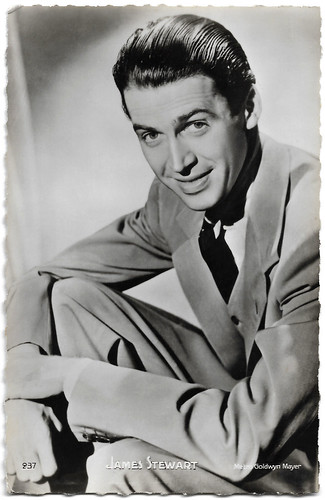
French postcard by Editions P.I., Paris, for S.A. Victoria, Brussels, no. 237. Photo: Metro-Goldwyn-Mayer, 1950.
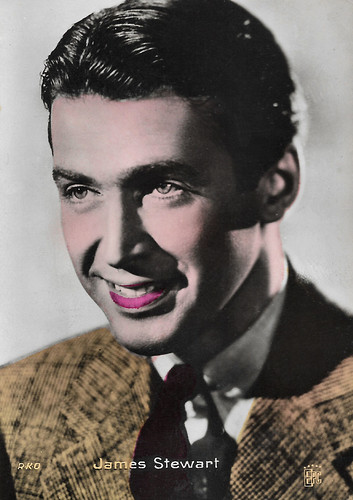
French card by EPC. Photo: RKO.

German postcard by Ross Verlag, no. A 1158/1, 1937-1938. Photo: 20th Century Fox. Simone Simon and James Stewart in Seventh Heaven (Henry King. 1937).

Dutch postcard, no. a.x. 253. Photo: Metro-Goldwyn-Mayer. June Allyson and James Stewart in The Stratton Story (Sam Wood, 1949).

German postcard by Rüdel-Verlag, Hamburg-Bergedorf, no. 397. Photo: Paramount. James Stewart in The Greatest Show on Earth (Cecil B. DeMille, 1952).

French postcard in the Collection Magie Noire nu Editions Hazan, Paris, no. 6490, 1996. James Stewart, Grace Kelly and Alfred Hitchcock at the set of Rear Window (Alfred Hitchcock, 1954).
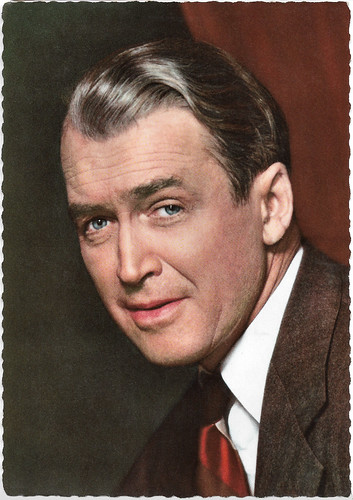
Belgian postcard by Edition H. Troukens, Hofstade, licence holder for Universum-Film Aktiengesellschaft (UFA), Berlin-Tempelhof, no. 1037. Photo: UFA.
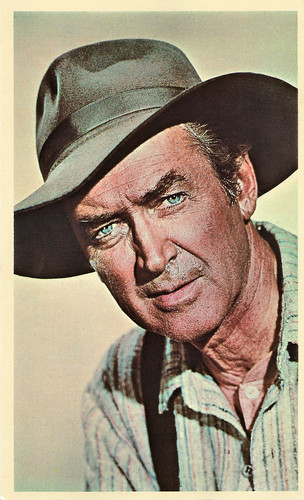
American postcard by Universal Pictures Company, Inc., 1965. Photo: Universal. James Stewart in Shenandoah (Andrew V. McLaglen, 1965).
Source: Britannica, Wikipedia, and IMDb.
No comments:
Post a Comment